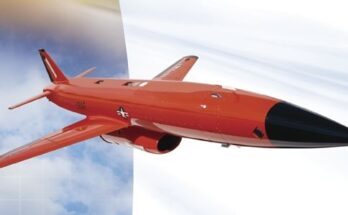by David Hutchins and Shaun McDougall

The Biden administration unveiled its inaugural National Defense Industrial Base Strategy earlier this month, outlining the military’s plans to bolster the domestic supply base and cultivate a thriving defense industry that can effectively deliver capabilities to warfighters. The strategy has lofty goals that simultaneously involve various reform efforts in the areas of acquisition, exports, budgeting, and the industrial base itself. Broad strategy documents can offer an important look into an administration’s priorities, but they are also complex plans that require long-term follow-through from government and military leaders, Congress, and industry.
What’s In The Strategy?
The 2022 National Defense Strategy (NDS) requires the DoD to coordinate with domestic and international partners in order to fortify the defense industrial base, U.S. logistics, and relevant global supply chains. Consequently, the National Defense Industrial Strategy (NDIS) provides a strategic vision for building a modernized defense industrial ecosystem. The NDIS sets forth four long-term strategic priorities that serve as guidance for industrial action and resource prioritization in developing a modernized defense industrial ecosystem.
- Resilient Supply Chains:
A globalized economy certainly has its benefits, however, global supply chains are not without risk. This is made evident when global pandemics hit or geopolitical tensions necessitate shifting supply chains away from rivals. Developments such as these, supplemented by ongoing conflicts in Ukraine and the Middle East, accentuate the need to produce products, services, and technologies at speed, scale, and cost without being hindered by supply chain issues. With this in mind, the DOD is seeking to minimize risk and improve the overall resilience of its supply chains. To achieve this, the DOD is prioritizing several efforts, such as supporting domestic production, diversifying its supplier base, investing in new production methods and accelerators, rebuilding stockpiles, and improving the Foreign Military Sales (FMS) process.
- Workforce Readiness:
To maintain a competitive advantage, or at least avoid falling behind the competition, the defense industrial base must leverage a strengthened workforce. By investing in our human capital, the DOD seeks to increase productivity, foster innovation, and onshore critical manufacturing. To achieve this, the DOD plans to prepare the workforce for future innovation by increasing access to apprenticeship and internship programs, reducing stigmatization of industrial careers, expanding recruitment of non-traditional communities, and targeting critical skill sets—especially science, technology, engineering, and mathematics.
- Flexible Acquisition:
The Defense Department has often been criticized for its complex and protracted acquisition process. Maintaining the status quo would likely result in lengthy development timelines, rising costs, limited scalability, and technological obsolescence. Therefore, the DOD seeks to circumvent these risks by adopting a more flexible acquisition process that balances efficiency, customization, and standardization. In particular, the DOD will prioritize commercial off-the-shelf (COTS) acquisition over customized solutions, when appropriate, to facilitate rapid delivery of critical capabilities. Concurrently, the DOD plans to improve acquisition by broadening its list of industry partners, increasing its access to intellectual property and data rights, and reducing “scope creep” through strengthened requirements.
- Economic Deterrence:
A key component of American soft power has been the strength and effectiveness of its economy. The theory behind this strategic priority is that a fear of reduced access to the strong economic market shared by the U.S. and its close international partners will deter potential aggressors. To address this priority, the DoD plans to strengthen economic security agreements, increase participation in standard-setting bodies, fortify alliances through shared science and technology, and safeguard the defense industrial base from cyber threats and adversarial intrusion.
Challenges & Uncertainties
The NDIS is a nascent strategy document whose implementation plan won’t be rolled out until next month, but there are some early questions to be asked and clear challenges to overcome. Perhaps the biggest issues that will dictate a successful implementation of the strategy are the administration’s financial investment and the response from Congress. The strategy requires long-term investment in industrial base capacity at a time when the U.S. defense budget is facing topline spending limits and potential sequestration cuts. The administration needs to be clear about what resources are required to implement the strategy and identify what, if any, tradeoffs must be made elsewhere in the budget.
Of course, any planned investments must be approved by Congress, which is currently struggling to pass an FY24 defense spending bill that is nearly four months late and counting. The supplemental spending package proposed by the Biden administration for Ukraine aid and other purposes also includes a $3.4 billion investment in the submarine industrial base, but that legislation is also in limbo on the Hill. Congress could also interject its own spin on policy provisions related to the NDIS. For example, some lawmakers may take issue with the administration’s approach to addressing race or gender gaps in the workforce portion of the strategy. A separate and ongoing budget reform commission could also impact implementation, but hopefully for the better. The commission has called for modernizing information systems, increasing information sharing, and providing increased flexibility for the Pentagon that could facilitate portions of the NDIS, but implementing those budgetary reforms will be its own unique challenge.
The DoD has already been capitalizing on flexible acquisition practices through the increased use of rapid prototyping authorities to get new technologies into the field faster, but long-term costs pose a challenge. When rapidly deploying new technologies at scale, such as the new Replicator program that aims to acquire thousands of new drones, the Pentagon needs to account for the cost of training personnel to use the equipment, maintaining it in the field when it breaks, potentially upgrading it in the future, and eventually replacing it. Failure to fully account for those future costs can result in even greater challenges down the road. Rigorous and realistic assessments of program requirements are also needed to avoid “scope creep,” but it can be difficult to fight the urge to add “just one more thing” when developing a new weapon system. The Pentagon must also walk a fine line about bolstering domestic capabilities while also maintaining healthy industry relationships with allies and partners.
Potential Impact on Defense Trends
Two practices that will see continued growth in military acquisitions are modular open system approach (MOSA) and COTS. The former is a process that prioritizes open system architectures and licensing that reduces the government’s reliance on proprietary technologies from specific manufacturers. The use of plug-and-play systems — what the strategy describes as “black boxes” — is intended to foster increased competition and lower costs of upgrades and sustainment. The use of open systems architectures is particularly important at a time when the Pentagon is outfitting myriad sensors and capabilities onto unmanned platforms of various sizes across multiple domains. A contractor’s ability to prioritize open systems and provide maximum flexibility will serve as an incentive during contract negotiations. At the same time, the military has often struggled to adapt as quickly as the commercial industry, which is understandable when the military buys equipment that remains in service for decades. The use of COTS will also be prioritized when it can accelerate development timelines or reduce costs without negatively impacting the warfighter.
The Pentagon will continue to foster relationships with more small business and non-traditional contractors. These efforts can expand the military’s exposure to commercial solutions from companies that may not have the resources of a large defense contractor but still bring new and innovative capabilities to the table. However, the Pentagon must incentivize these companies to compete for defense contracts by simplifying bureaucratic obstacles and addressing potential investment barriers for startups. Long-running cybersecurity efforts that protect industrial base networks will also see additional investment as more companies are brought into the fold.
Over the past several decades, China has become a powerhouse in the mining of rare earth elements and production of microelectronics, which are critical to the production of military systems. The U.S. has already begun investing more heavily in the domestic manufacturing of these materials, while also trying to slow China’s own growth by limiting the supply of U.S.-sourced semiconductors and artificial intelligence technologies. Whether these roadblocks impact Chinese growth remains to be seen, but in either case, the U.S. will continue to work on increasing domestic sourcing of these goods. The DoD will also continue working to establish redundancies for military hardware that utilize single-source components, which represent a particularly high risk to the military.
There will be a continued push within the Pentagon to secure technological data rights when negotiating new arms deals. When the military owns the data rights for a system, it can have companies compete more easily for upgrades and sustainment projects, rather than relying on the original manufacturer. Some programs, such as the Joint Light Tactical Vehicle, have even seen production lines switch companies because of cost-saving recompetes. The Air Force also secured data rights when negotiating its HH-60W and MH-139 helicopter programs, and data rights are sure to come into play as programs like Next Generation Air Dominance get off the ground. Data in all forms will play a major role in reducing costs and hunting for efficiencies, such as using AI to track logistics requirements and inventories and ensure the correct flow of spare and repair parts. The DoD will also continue efforts to increase stockpiles of critical components to reduce the risk of supply chain disruptions.
It’s unclear if the NDIS will unfold in its current form, but many of the issues discussed in the strategy are already long-standing priorities that will continue to inform the Pentagon’s interactions with industry regardless of what happens with the overarching document. For now, onlookers will await the release of the strategy’s implementation plan and keep a watchful eye on investments in the upcoming FY25 budget request to see how the strategy unfolds.
For 50 years, Forecast International intelligence reports have been the aerospace and defense industry standard for accurate research, analysis, and projections. Our experienced analysts compile, evaluate, and present accurate data for decision makers. FI's market research reports offer concise analysis of individual programs and identify market opportunities. Each report includes a program overview, detailed statistics, recent developments and a competitive analysis, culminating in production forecasts spanning 10 or 15 years. Let our market intelligence reports be a key part of reducing uncertainties and mastering your specific market and its growth potential. Find out more at www.forecastinternational.com



